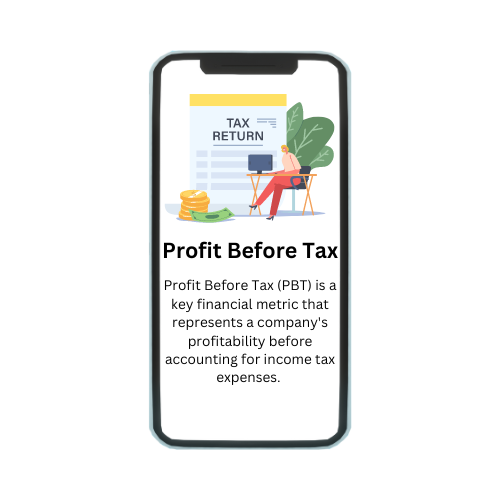Profit Before Tax (PBT) is a key financial metric that represents a company’s profitability before accounting for income tax expenses. It provides insight into a company’s operating performance and is calculated by subtracting all operating expenses, interest expenses, and other non-operating costs from total revenue, but before deducting tax expenses. PBT is crucial because it highlights how well a company is generating profit from its core operations without the influence of tax strategies or varying tax rates. This measure allows investors and analysts to evaluate a company’s operational efficiency and profitability trends across different periods or compare it with peers, providing a clearer picture of the company’s financial health and its ability to generate sustainable earnings.
Understanding Profit before Tax
Profit Before Tax (PBT) is a fundamental financial indicator that reveals a company’s earnings before the deduction of income taxes. It is calculated by subtracting operating expenses, interest expenses, and other relevant costs from total revenue, but before accounting for taxes. This metric is significant because it provides a clear view of a company’s operational efficiency and financial performance independent of tax considerations. PBT is used to assess the profitability of a company’s core business activities and compare its performance with other businesses or industry standards. By isolating earnings from tax effects, PBT helps stakeholders understand the underlying operational success of a company and make more informed decisions about its financial health and potential for growth. The formula to calculate PBT is:
PBT = Revenue − Expenses − Interest
Components Affecting Profit Before Tax
Several key components influence Profit Before Tax (PBT), shaping a company’s profitability before tax expenses are considered:
- Revenue: The total income generated from sales of goods or services is the primary driver of PBT. Higher revenue typically boosts PBT, assuming costs and expenses are managed effectively.
- Operating Expenses: These include costs directly related to the core business operations, such as salaries, rent, utilities, and raw materials. Lower operating expenses can lead to a higher PBT, reflecting better operational efficiency.
- Interest Expenses: Costs associated with borrowed funds, such as interest on loans or credit, are deducted when calculating PBT. Higher interest expenses reduce PBT, while lower interest costs improve it.
- Non-Operating Costs: These are expenses not directly tied to the primary business activities, such as losses from investments or asset write-downs. Effective management of these costs can positively impact PBT.
- Depreciation and Amortization: These non-cash expenses represent the allocation of the cost of tangible and intangible assets over their useful lives. They reduce PBT by spreading out the initial cost of assets.
- One-Time Expenses and Income: Unusual or non-recurring items, such as restructuring costs or asset sales, can significantly impact PBT. Adjusting for these items helps in assessing the underlying operational performance.
How to Calculate Profit Before Tax
To calculate Profit Before Tax (PBT), start with the company’s total revenue, which includes all income earned from its core business activities. From this revenue, subtract the cost of goods sold (COGS) to determine the gross profit. Next, deduct all operating expenses, such as salaries, rent, utilities, and other costs essential to running the business. This yields the operating profit. From the operating profit, subtract any non-operating expenses, such as interest on loans and non-recurring costs, to obtain the pre-tax profit. Essentially, PBT is calculated using the formula:
PBT = Total Revenue – COGS − Operating Expenses − Non-Operating Expenses
This metric reflects the company’s profitability before the impact of income tax, providing a clear view of its operational efficiency and financial performance before tax considerations are applied.
Examples and Scenarios
To illustrate how Profit Before Tax (PBT) works in practice, consider two different business scenarios.
Scenario 1: Tech Startup A tech startup generates $5 million in revenue. Its cost of goods sold (COGS) amounts to $1.5 million, leaving a gross profit of $3.5 million. The startup incurs $2 million in operating expenses, including salaries and rent, resulting in an operating profit of $1.5 million. Additionally, it pays $200,000 in interest on loans. The calculation for PBT would be:
PBT = $5,000,000 − $1,500,000 − $2,000,000 − $200,000 = $1,300,000
Scenario 2: Manufacturing Firm A manufacturing firm earns $10 million in revenue with COGS of $6 million, giving a gross profit of $4 million. Operating expenses, including factory maintenance and administrative costs, total $1.5 million, so the operating profit is $2.5 million. The firm has $500,000 in non-operating expenses and no interest expenses. The PBT calculation would be:
PBT = $10,000,000 − $6,000,000 − $1,500,000 − $500,000 = $2,000,000
Profit Before Tax in Financial Statements
In financial statements, Profit Before Tax (PBT) appears as a crucial indicator of a company’s operational profitability before tax expenses are deducted. Here are key points on its presentation:
- Income Statement: PBT is typically listed in the income statement, following the calculation of gross profit and operating profit. It is usually situated just above the income tax expense section, providing a clear distinction between earnings before and after tax deductions.
- Gross Profit: The calculation begins with total revenue, from which the cost of goods sold (COGS) is subtracted to determine gross profit.
- Operating Profit: From gross profit, operating expenses (such as salaries, rent, and utilities) are deducted to arrive at operating profit. This reflects the core profitability of the business.
- Non-Operating Expenses: Interest expenses and other non-operating costs are then subtracted from the operating profit to calculate PBT. This step accounts for costs not directly tied to core operations.
- Financial Analysis: Analysts use PBT to assess a company’s financial health and operational efficiency, as it provides insight into profitability without the impact of tax variations. Comparing PBT across periods or with other companies helps evaluate performance and financial stability.
- Investor Insight: PBT helps investors understand the underlying performance of a company, allowing for better comparisons between companies with different tax situations and evaluating the effectiveness of management in generating profits.
Implications of Profit Before Tax
Understanding Profit Before Tax (PBT) has several important implications for evaluating a company’s financial health and performance:
- Operational Efficiency: PBT provides insight into a company’s operational efficiency by highlighting profitability from core business activities before tax effects. Higher PBT suggests effective management and strong operational performance, while lower PBT may indicate issues with cost control or revenue generation.
- Financial Comparison: PBT allows for more accurate comparisons between companies, especially across different jurisdictions with varying tax rates. Since it excludes tax impacts, it enables stakeholders to assess and compare operational performance on a level playing field.
- Investment Decisions: Investors use PBT to gauge the potential for future profitability and growth. A consistently high PBT can signal a healthy business with strong earning potential, making it an attractive investment opportunity.
- Management Performance: PBT can be a measure of management’s ability to drive profits through operational strategies and cost management. It reflects how well the company is performing before the effects of tax planning and other financial maneuvers.
- Tax Strategy Evaluation: While PBT does not account for tax expenses, it is a crucial starting point for understanding how tax planning impacts overall profitability. Companies with high PBT might benefit from effective tax strategies to further enhance net income.
- Financial Forecasting: Analysts use PBT in forecasting and budgeting to predict future performance and profitability. It helps in setting realistic financial targets and assessing the impact of potential business changes or market conditions.
Challenges in Analyzing Profit Before Tax
Analyzing Profit Before Tax (PBT) presents several challenges that can impact the accuracy and comprehensiveness of financial assessments:
- Non-Operating Items: PBT includes various non-operating items, such as interest expenses and one-time gains or losses, which can distort the true picture of operational performance. These items may skew the analysis if not properly accounted for or adjusted.
- Comparability Issues: Differences in accounting policies, such as depreciation methods or revenue recognition practices, can affect PBT. These variations make it difficult to compare PBT across companies or industries without adjusting for these factors.
- Tax Planning Effects: While PBT excludes tax effects, aggressive tax planning or tax strategies can impact the financial statements. Companies with significant tax shelters or deferred tax assets might present a misleading picture of operational profitability.
- Accounting Estimates: PBT is influenced by accounting estimates and judgments, such as asset impairments or provisions. These estimates can vary between companies and affect the reliability of PBT as an indicator of true financial performance.
- Revenue Recognition: Variations in revenue recognition practices, such as recognizing revenue at different stages of a project or transaction, can affect PBT. Inconsistent practices make it challenging to compare PBT across entities.
- Currency Fluctuations: For multinational companies, currency exchange rates can impact PBT. Fluctuations in foreign exchange rates can create variability in reported PBT, complicating comparisons and trend analyses.
- One-Time Adjustments: Companies may have one-time adjustments or extraordinary items that impact PBT. These can obscure the underlying operational performance and require careful analysis to distinguish between recurring and non-recurring items.
How Investors Use Profit Before Tax
Investors use Profit Before Tax (PBT) as a key metric to evaluate a company’s financial performance and potential for growth. By analyzing PBT, investors can gain insight into a company’s operational efficiency and profitability from its core business activities, excluding the effects of tax strategies and varying tax rates. This allows for a clearer comparison of performance across different companies and industries. A consistently high PBT indicates strong management performance and a robust business model, which can be appealing to investors seeking stable returns. Additionally, PBT helps investors assess the company’s ability to generate profit before tax expenses, which is crucial for forecasting future earnings and setting investment targets. By focusing on PBT, investors can make more informed decisions about a company’s value and growth prospects, understanding that it provides a snapshot of the company’s financial health independent of tax-related variables.
Conclusion
In conclusion, Profit Before Tax (PBT) serves as a vital financial metric that provides a clear view of a company’s profitability from its core operations, excluding the effects of tax expenses. It highlights how effectively a company is managing its revenue and controlling costs, offering valuable insights into operational efficiency and financial performance. For investors, PBT is instrumental in assessing a company’s underlying profitability, enabling more accurate comparisons across firms and industries, regardless of tax structures. It also helps in evaluating management performance and forecasting future earnings potential. However, analyzing PBT requires careful consideration of non-operating items, accounting practices, and other factors that might influence its accuracy. By understanding and leveraging PBT, stakeholders can make more informed decisions, gain a better grasp of a company’s financial health, and strategically plan for investment opportunities and business growth.







